Chiu Chia-hao (邱家豪) once desperately chased down a butcher truck to obtain caul fat to recreate his late grandma’s signature dragon-phoenix leg (龍鳳腿), a fish paste snack made to resemble chicken wings. And Cheng Ching-teng (鄭靖騰) thought he came across the perfect specimen to make his heritage cuttlefish balls, only to find that it was not suitable for blending into paste.
“Dad told me, and I didn’t listen,” Cheng laughs.
Having little formal training, the two went through much trial and error until they perfected their family traditions. Even after 52 years in the fish ball business, Shih Mo-chou (石莫愁) wakes up at 3am every day to personally taste the shop’s pastes, vividly recounting all the times that things went wrong when she didn’t do so.

Photo: Han Cheung, Taipei Times
Chiu’s Dragon-Phoenix Leg (邱記龍鳳腿), Cheng’s Da Fong Fish Ball (大豐魚丸) and Shih’s Xie Cheng Fish Ball (協成魚丸) were among 30 nationwide winners in the government-sponsored Fish Paste King competition (魚漿王爭霸戰), the results of which were announced late last month. The offerings were colorful and diverse, as fish or seafood paste is a staple of the Taiwanese diet and can come in countless shapes and forms, from balls to cakes to dumplings.
In the old days, it was a way to make use of excess fish and unsellable specimens or scraps, but today fish-paste products are ubiquitous as snacks at night markets or side dishes in Taiwanese eateries.
XIE CHENG FISH BALL (協成魚丸)
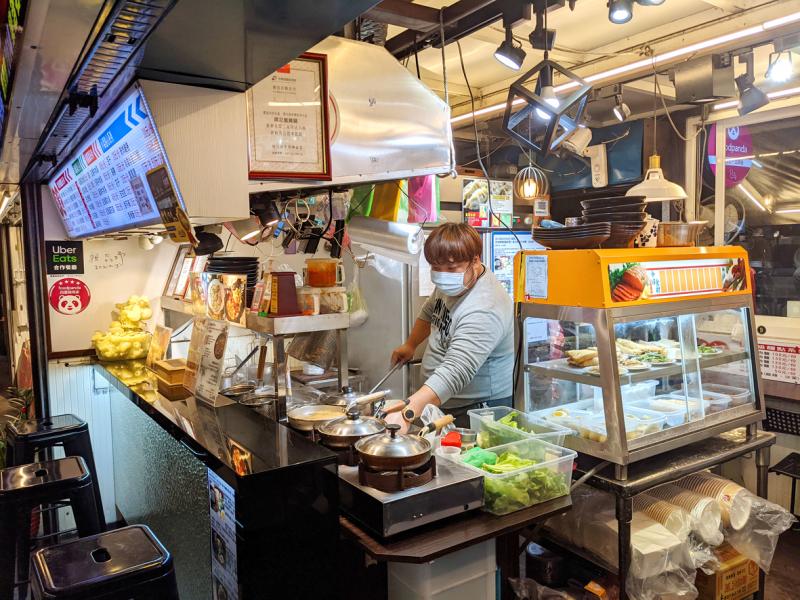
Photo: Han Cheung, Taipei Times
Growing up in a wealthy, scholarly family, Shih was clueless about food preparation until she opened up shop with her husband at the age of 23. Her late husband was having difficulty finding work, so a fish vendor at Taipei’s Dalong Market (大龍市場) suggested that they start a fish ball operation, which was lucrative at that time.
Shih’s husband was in charge of hand-mincing the paste and other heavy tasks, and they hired workers to help out, but the taste, shape, texture and creative process all went through Shih. She laughs that once she changed the recipe for her tempura eight times, and her husband would often complain that she would be tweaking something for 364 days per year, only taking Lunar New Year off.
Today, the shop is located in Lanzhou Street Market (蘭州市場) with two branches in Shihlin District. Shih’s mother also didn’t know how to cook, but encouraged her to experiment. At one point Shih had created 48 different offerings (not all of them included fish paste). Last month’s award-winning products are swordfish balls with celery and shrimp rolls.
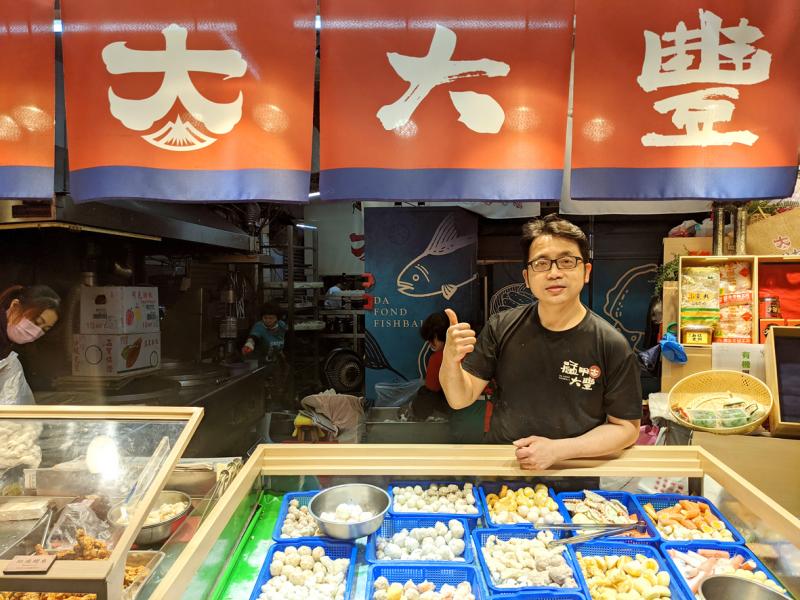
Photo: Han Cheung, Taipei Times
Today the shop only sells a handful of its former creations not just due to some ingredients being hard to source, but also because of Shih’s old age. Shih still insists on personally mixing the paste and tasting it before it can be sold. Once, she was so angry that one of her long-time staff messed up a large order that she vomited on the spot, furious that her decades-old name was tarnished.
“Everything has to pass through my mouth,” she says. “I’ll even taste it if it’s raw. I’m very insistent and attentive, and I will not stop trying until it’s acceptable. I’m also very meticulous with cleanliness.”
Xie Cheng Fish Ball (協成魚丸)
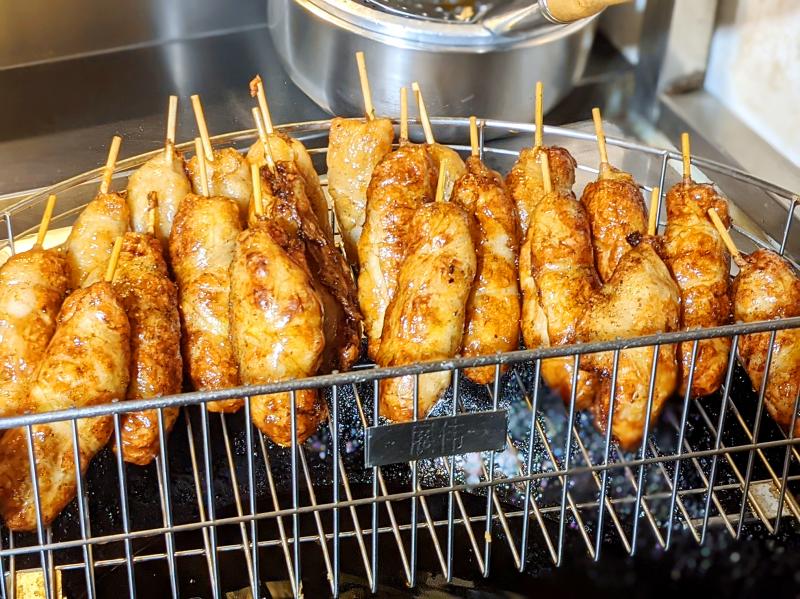
Photo: Han Cheung, Taipei Times
Stall #148, Lanzhou Market, 55 Changji St, Taipei City (台北市昌吉街)
Open: Tuesday to Sunday from 7:30 to 1pm
Tel: (02) 2592-1307
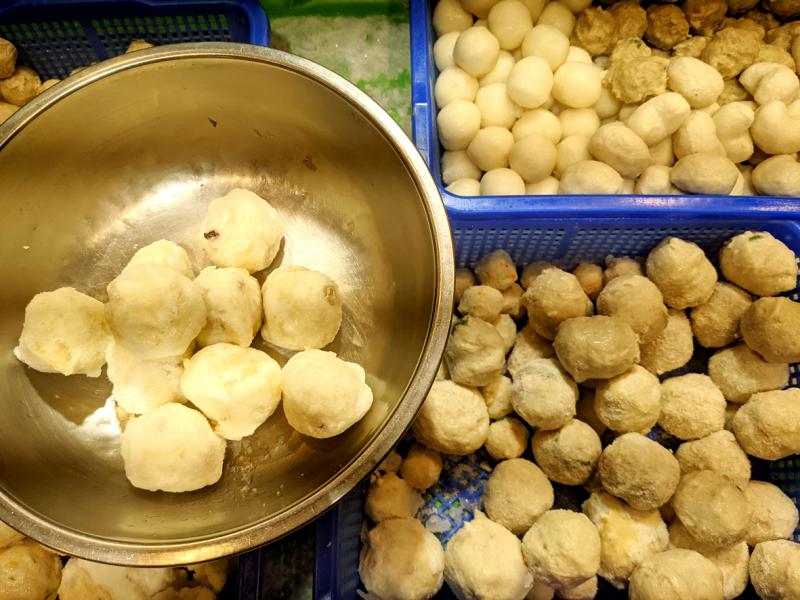
Photo: Han Cheung, Taipei Times
On the Net: www.fishball.idv.tw
CHIU’S DRAGON-PHOENIX LEG (邱記龍鳳腿)
After the Chiu family conducted their annual ancestor worship ceremony, which included a chicken offering, there was always a dilemma: How would they split two drumsticks between 10 hungry children? To prevent bickering, Chiu’s grandmother would always fry up a batch of dragon-phoenix legs and tell the kids that this was dragon-phoenix meat, which is more precious than chicken.
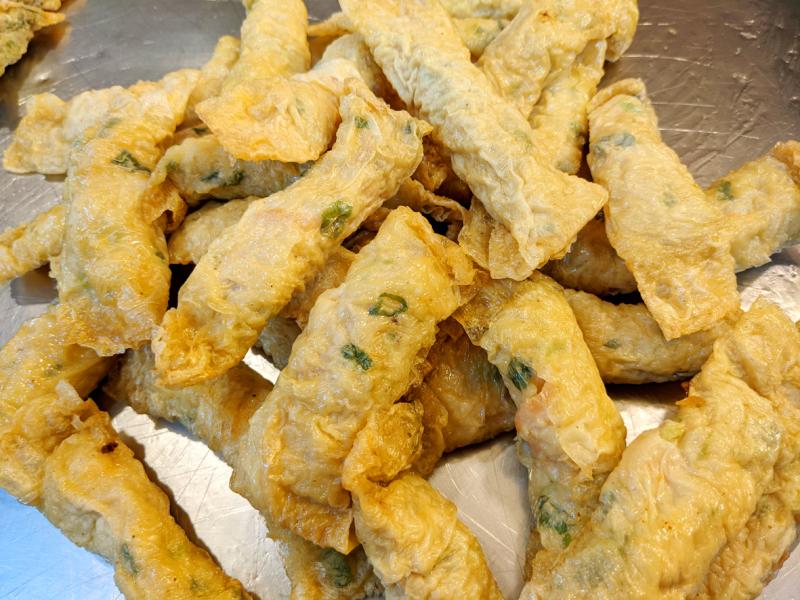
Photo: Han Cheung, Taipei Times
Of course the Chiu’s didn’t invent the snack, it has since the 1850s been a speciality of New Taipei City’s Rueifang District (瑞芳). But Chiu laments that outside of his hometown, few people know what it is. When he took over the shop in New Taipei City’s Sijhih Tourist Night Market (汐止觀光夜市) last year after his father got sick, he decided to draw people in with the more familiar beef noodles and dumplings first, then try to introduce the dragon-phoenix leg.
At NT$17 per “leg,” it’s a complex dish consisting of shark paste, cabbage, spring onions, onions, water chestnut and fatty pork wrapped in layers of caul fat membrane. The caul fat is the hardest to obtain due to modern pig slaughtering methods, but Chiu refuses to use bean curd as a substitute.
“Of course the beef noodles are more lucrative, but there are certain principles one must insist on while doing business,” he says. “This is my father’s shop. I can’t just dismiss everything he’s done, otherwise he’ll feel sad when he comes to visit. I’m still young, and I have time to insist, share and preserve traditions.“
Chiu’s Dragon-Phoenix Leg (邱記龍鳳腿)
Stall #13, Sijhih Tourist Night Market (汐止觀光夜市), Sijhih District, New Taipei City (新北市汐止區)
Open: Daily from 5am to 11:30pm
Tel: (02) 8691-6396
On the Net: tinyurl.com/yyd6rtg8
DA FONG FISH BALL
Cheng worked in sales for an electronics firm before returning home to promote the goods of his family business, which his grandfather first launched in Keelung in 1957. If he was hawking other people’s products, he might as well do his own, he says.
The family relocated to Wanhua shortly after the shop opened, and began manufacturing swordfish balls out of their home. Cheng’s father opened two stores, one at today’s location at Dongsanshui Street Market (東三水街市場).
Since Cheng was doing mostly sales, he had much to learn about fish paste production after his father died, even traveling to Kaohsiung to visit an old master.
He retains the original swordfish balls — although he reduced the oil content to fit today’s health trends — and other classic staples such as the cuttlefish balls and tempura. But ever since tourists began visiting the area due to the nearby Bopiliao Historic Block (剝皮寮歷史街區) and adjacent Xinfu Market (新富市場), he’s added street snacks such as fried burdock root.
Although Cheng speaks glowingly of his swordfish products, he submitted the cuttlefish ball to the contest as he confidently states that it is the only such product in Taiwan that is purely cuttlefish — others mix in fish paste and other ingredients to save costs. Before it was made only with cuttlefish legs since the head cannot be made into paste, but Cheng is now adding chunks of chewy head into the mix “because young people like it more.”
“But the old people have trouble chewing it, so I make two types now,” he says. “The key to good business is to constantly ask the opinion of your customers and improve accordingly.”
Da Fong Fish Ball (艋甲大豐)
Stall #44, Dongsanshui Street Market (東三水街市場) 62, Sanshui Street, Taipei City (台北市三水街62號)
Open: Tuesday to Sunday from 8am to 3pm
Tel: (02) 2306-0532
On the Net: www.facebook.com/DAFONDFISHBALL1957

April 14 to April 20 In March 1947, Sising Katadrepan urged the government to drop the “high mountain people” (高山族) designation for Indigenous Taiwanese and refer to them as “Taiwan people” (台灣族). He considered the term derogatory, arguing that it made them sound like animals. The Taiwan Provincial Government agreed to stop using the term, stating that Indigenous Taiwanese suffered all sorts of discrimination and oppression under the Japanese and were forced to live in the mountains as outsiders to society. Now, under the new regime, they would be seen as equals, thus they should be henceforth

Last week, the the National Immigration Agency (NIA) told the legislature that more than 10,000 naturalized Taiwanese citizens from the People’s Republic of China (PRC) risked having their citizenship revoked if they failed to provide proof that they had renounced their Chinese household registration within the next three months. Renunciation is required under the Act Governing Relations Between the People of the Taiwan Area and the Mainland Area (臺灣地區與大陸地區人民關係條例), as amended in 2004, though it was only a legal requirement after 2000. Prior to that, it had been only an administrative requirement since the Nationality Act (國籍法) was established in

With over 100 works on display, this is Louise Bourgeois’ first solo show in Taiwan. Visitors are invited to traverse her world of love and hate, vengeance and acceptance, trauma and reconciliation. Dominating the entrance, the nine-foot-tall Crouching Spider (2003) greets visitors. The creature looms behind the glass facade, symbolic protector and gatekeeper to the intimate journey ahead. Bourgeois, best known for her giant spider sculptures, is one of the most influential artist of the twentieth century. Blending vulnerability and defiance through themes of sexuality, trauma and identity, her work reshaped the landscape of contemporary art with fearless honesty. “People are influenced by

The remains of this Japanese-era trail designed to protect the camphor industry make for a scenic day-hike, a fascinating overnight hike or a challenging multi-day adventure Maolin District (茂林) in Kaohsiung is well known for beautiful roadside scenery, waterfalls, the annual butterfly migration and indigenous culture. A lesser known but worthwhile destination here lies along the very top of the valley: the Liugui Security Path (六龜警備道). This relic of the Japanese era once isolated the Maolin valley from the outside world but now serves to draw tourists in. The path originally ran for about 50km, but not all of this trail is still easily walkable. The nicest section for a simple day hike is the heavily trafficked southern section above Maolin and Wanshan (萬山) villages. Remains of